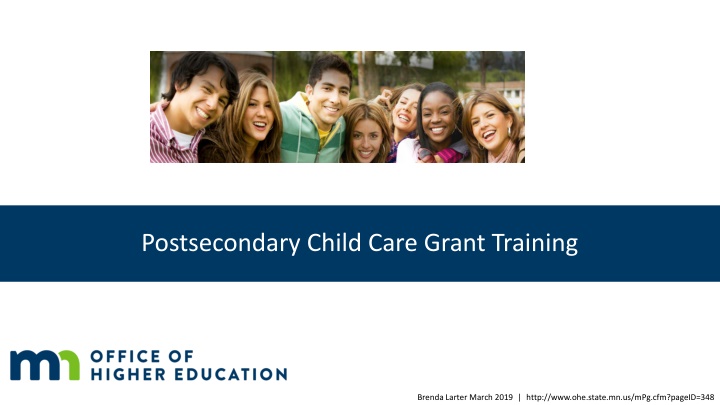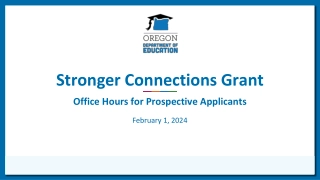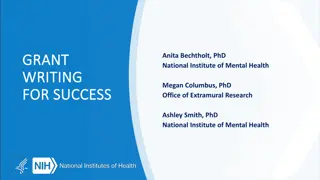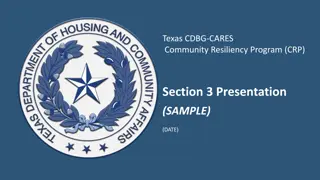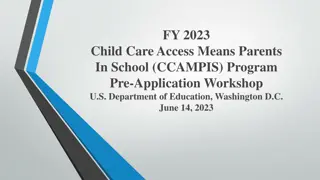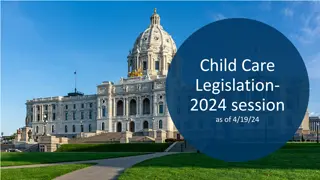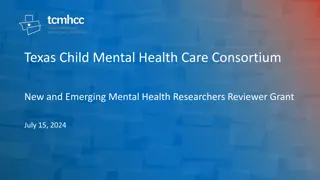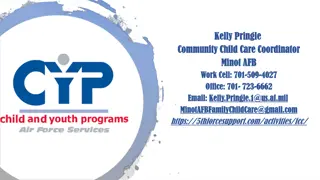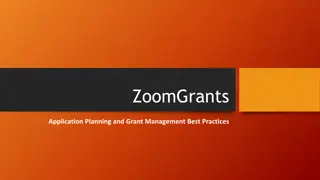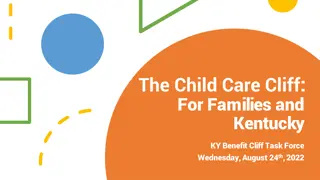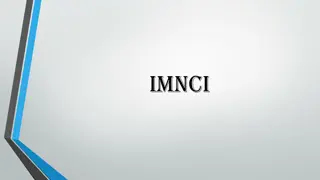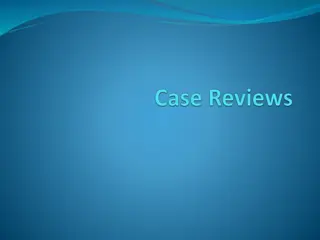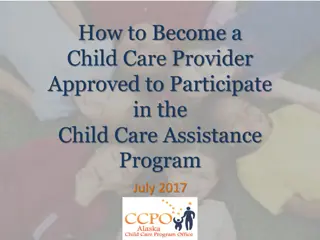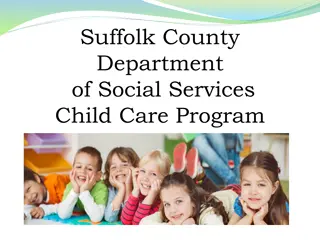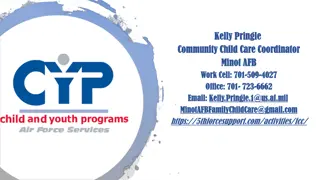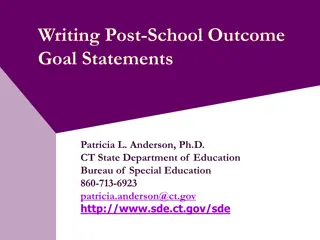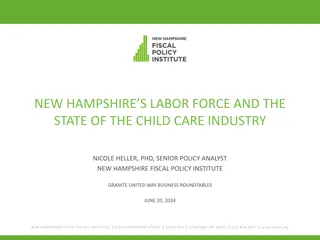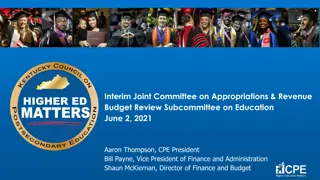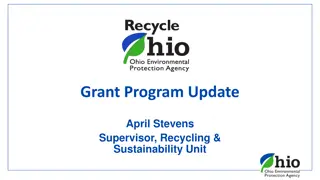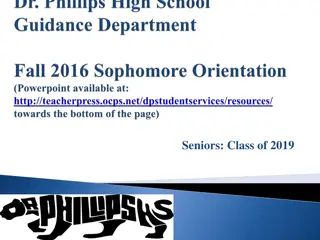Postsecondary Child Care Grant Program
This program offers financial assistance to postsecondary students in Minnesota who require child care support for their dependent children. Eligible students must meet specific residency criteria, and the program aims to alleviate financial burdens for those in need. Students attending eligible institutions in Minnesota can benefit from this grant to pursue their education without added child care worries.
Download Presentation

Please find below an Image/Link to download the presentation.
The content on the website is provided AS IS for your information and personal use only. It may not be sold, licensed, or shared on other websites without obtaining consent from the author.If you encounter any issues during the download, it is possible that the publisher has removed the file from their server.
You are allowed to download the files provided on this website for personal or commercial use, subject to the condition that they are used lawfully. All files are the property of their respective owners.
The content on the website is provided AS IS for your information and personal use only. It may not be sold, licensed, or shared on other websites without obtaining consent from the author.
E N D
Presentation Transcript
Postsecondary Child Care Grant Training Firstname Lastname | Job Title Date Brenda Larter March 2019 | http://www.ohe.state.mn.us/mPg.cfm?pageID=348
Program Purpose To provide financial assistance to students with financial need pursuing a postsecondary education who require child care assistance for their dependent children and do not receive funds from the Minnesota Family Investment Program (MFIP). Brenda Larter | http://www.ohe.state.mn.us/mPg.cfm?pageID=348
Eligible Institutions Minnesota public postsecondary institutions. Minnesota private baccalaureate degree granting college or university (non-profit or for-profit). Minnesota non-profit two-year vocational school granting associate degrees. The institution must also meet the definition of eligible institution in MN statutes (MS) 136A.103. School must sign institutional participation agreement with Office of Higher Education (OHE). School must also submit annual program participation form, which indicates anticipated funding needs for the coming year. Brenda Larter | http://www.ohe.state.mn.us/mPg.cfm?pageID=348
Eligible Student Meet ONE of the following MN resident criteria: Student who graduated from a MN high school while residing in MN and, if currently residing in another state is physically attending college in MN; or Student who earned GED in MN after living in MN for one year; or Dependent students whose parents resided in MN when FAFSA completed; or Student who resided in MN for 12 consecutive months without being enrolled half-time or more in any term. Undergraduates 6 credits, graduate/professional 1 credit; or Brenda Larter | http://www.ohe.state.mn.us/mPg.cfm?pageID=348
Eligible Student Student who resided in MN for 12 consecutive months without being enrolled half-time in any term, does not have to be initial year student lived in MN. Residency established this way is lost if student later leaves MN for more than one year (unless for college, military, missionary service and still pay taxes to MN). Does not apply to GED recipients; or Independent student who originally met residency requirement as a dependent because parents resided in MN when FAFSA completed are grandfathered as an independent student if student continues to live in MN; or Brenda Larter | http://www.ohe.state.mn.us/mPg.cfm?pageID=348
Eligible Student Families not penalized for leaving MN to attend college or serve in military or missionary service if still paying taxes in MN. A member, spouse or dependent of the armed forces of the US stationed in MN on active federal military service as defined in MS 190.05, Subd. 5c; or A spouse or dependent of a veteran who meets the residency requirement; or A person or spouse of who relocated to MN from an area that is declared a presidential disaster area within the preceding 12 months, if the disaster interrupted the person s postsecondary education; or A person defined as a refugee under US code, title 8, section 1101 (a)(42) who upon arrival in the US, moved to MN and has continued to reside in MN. Brenda Larter | http://www.ohe.state.mn.us/mPg.cfm?pageID=348
Eligible Student MN Dream Act is part of state residency statute, requirements are: Attended MN high school for at least three academic years. Graduated from MN high school or earned MN GED. Meet selective service system (SSS) registration requirements: Must register with SSS if male 18-25 years old; If male 26 or older, must have registered when 18-25; Can attempt to get status letter from SSS to show failure to register wasn t knowing or willfull. Brenda Larter | http://www.ohe.state.mn.us/mPg.cfm?pageID=348
Eligible Student The definition of MN resident for the Postsecondary Child Care Grant Program ONLY, was revised to include a student whose spouse is a resident of MN. This would require the school to determine the spouse s residency status by having the spouse complete OHE s student eligibility questionnaire (appendix 2 of the State Grant manual). This change was effective for terms starting on or after August 1, 2015. The student must not be receiving Tuition Reciprocity benefits from a neighboring state to attend a MN institution. Brenda Larter | http://www.ohe.state.mn.us/mPg.cfm?pageID=348
Eligible Student Must be enrolled at least half-time in an undergraduate or graduate/professional program leading to a degree, certificate or diploma. Undergraduate student must be enrolled for 6-15 credits. Graduate/professional student must be enrolled for 1-6 credits in a graduate or professional program. A student can receive a Postsecondary Child Care Grant at more than one eligible institution as long as the student is enrolled in a program leading to a credential at one eligible institution. Interim term credits should be allocated to adjoining terms as described for the State Grant program. Brenda Larter | http://www.ohe.state.mn.us/mPg.cfm?pageID=348
Eligible Student The 2017 Legislature increased the limit on postsecondary education from four years to five years of postsecondary education. Five years of full-time attendance equals 120 units. Undergraduate students may exceed the maximum of 120 units by disbursing one more term of aid to a student attending a quarter system school who have not yet exceeded 118.4 units or students attending a semester system school who have not yet exceeded 117.6 units. Graduate students may exceed the maximum of 120 units by disbursing one more term of aid to a student attending a quarter system school who have not yet exceeded 118.7 units or students attending a semester system school who have not yet exceeded 118 units. Brenda Larter | http://www.ohe.state.mn.us/mPg.cfm?pageID=348
Eligible Student The institution is responsible for reviewing transcripts. Students who had to withdraw for active military services after December 31, 2002 can receive one extra term of eligibility. Exclude courses for which a student withdrew for a term during which the student withdrew for a major medical illness as documented by a medical professional. Brenda Larter | http://www.ohe.state.mn.us/mPg.cfm?pageID=348
Eligible Student The student must be enrolled in a non-sectarian program or course of study. A non-sectarian program means a program of study that is not specifically designed to prepare students to become ministers of religion, to enter some other religious vocation, or to prepare them to teach theological subjects. Must be making satisfactory academic progress (SAP) requirements in state law. Which adopts the SAP requirements used for federal financial aid program. The federal requirements referred to in state law defined minimum standards for maintaining SAP, schools are allowed to adopt stricter standards. Brenda Larter | http://www.ohe.state.mn.us/mPg.cfm?pageID=348
Eligible Student The student must have a child 12 years of age or younger, or 14 years of age or younger who is disabled as defined in MS 125A.02, and who is or will be receiving care on a regular basis from a licensed or legal non-licensed care giver. If the child is 12 years of age at the start of the term, the child can be considered for an award for the entire term. Brenda Larter | http://www.ohe.state.mn.us/mPg.cfm?pageID=348
Eligible Student Child with a disability means a child who has a hearing impairment, blindness, visual disability, speech or language impairment, physical disability, other health impairment, mental disability, emotional health impairment, mental disability, emotional/behavioral disorder, specific learning disability, autism, traumatic brain injury, multiple disabilities, or deaf/blind disability who need special education and related services is a child with a disability. A licensed physician, an advanced practice nurse, or a licensed psychologist is qualified to make a diagnosis and determination of attention deficit disorder or attention deficit hyperactivity disorder for purposes of identifying a child with a disability. A child with a short term or temporary physical or emotional illness or disability is not a child with a disability. Brenda Larter | http://www.ohe.state.mn.us/mPg.cfm?pageID=348
Eligible Student The child must meet the requirements for inclusion in the independent student s household size or dependent student s parental household size, as specified in applicable Title IV program regulations. Foster children are not eligible. Brenda Larter | http://www.ohe.state.mn.us/mPg.cfm?pageID=348
Eligible Student It is possible for the child to be included in the household size on both parents FAFSA applications. If both students include the child in the household size on the FAFSA application, both can apply for a Postsecondary Child Care Grant. If one unmarried student is providing more than half the support for the other student, in addition to providing more than half the support for the child, that student can include both the child and other student/parent in the household size on the FAFSA. Brenda Larter | http://www.ohe.state.mn.us/mPg.cfm?pageID=348
Eligible Student The student receiving the support could not include the other student in the household size, but could include the child. For 50% support test, the student can include any funds received from someone other than the students parents that flow through to the child. Child s other parent, Government assistance programs. Brenda Larter | http://www.ohe.state.mn.us/mPg.cfm?pageID=348
Eligible Student For example, if a student who lives alone with her child, receives cash from her boyfriend that amounts to more than 50% support for her child, then she would be able to count the child as a dependent in her household size and apply as independent. If the boyfriend is the father of the child and a student himself, then he would also be able to count the child in his household size and apply as independent. You would award the first student and then have to subtract the award the first student received from the actual child care costs for the other student prior to determining the award amount for the second student. Brenda Larter | http://www.ohe.state.mn.us/mPg.cfm?pageID=348
Eligible Student The student must NOT be receiving benefits from the Minnesota Family Investment Program (MFIP). This applies even if MFIP child care assistance does not cover school hours. A student can get a pro-rated Postsecondary Child Care Grant if the student only received MFIP benefits for a portion of the term. Brenda Larter | http://www.ohe.state.mn.us/mPg.cfm?pageID=348
Eligible Student If student is only receiving MFIP benefits for a portion of a term, the student would be eligible for a prorated Postsecondary child Care Grant award for remainder of the term. Postsecondary Child Care Grant award does not have to be refunded to the program if the student receives MFIP benefits later in a term, provided the student notified the school within 10 days of the change of status. School can opt to adjust the award and bill the student for the overpayments, but in this case it is not required. If the student did not notify the school of the change, the student does not meet program eligibility requirements and should not receive future disbursements during the aid year, nor be considered a renewal applicant in future aid years. Brenda Larter | http://www.ohe.state.mn.us/mPg.cfm?pageID=348
Eligible Student If the student is excluded from receiving MFIP benefits, but the students children receive MFIP benefits, the student IS eligible for the Postsecondary Child Care Grant. Since many students do not know if the assistance they receive is under MFIP, if they indicate on their application that the family is receiving any type of public assistance, the school must collect documentation from the county verifying the student is excluded from receiving MFIP benefits. OHE created the MFIP CCAP Verification Form for you to use to determine what type of assistance the students is receiving from the county. Students who are not on MFIP, but receive other benefits such as General Assistance, MN Care Insurance, Medical Assistance, Food Stamps, or Diversionary Work Program (DWP) ARE eligible for the Postsecondary Child Care Grant. Brenda Larter | http://www.ohe.state.mn.us/mPg.cfm?pageID=348
Eligible Student Students receiving DWP are eligible for child care assistance through the DWP, so those benefits would be subtracted from actual child care costs used in the Postsecondary Child Care Grant award calculation. The DWP is a program families are referred to for four months prior to going on MFIP. Therefore, you need to follow-up with these students. Brenda Larter | http://www.ohe.state.mn.us/mPg.cfm?pageID=348
Eligible Student The student cannot be in default on any student loan. The student can regain eligibility retroactive to the beginning of the current aid year by producing documentation from the holder of the loan that it has been paid in full or otherwise satisfied. A student who has a hold on their State Grant file for being in arrears on child support payments IS eligible to participate in the Postsecondary Child Care Grant Program. According to statute this hold only prevents a student from receiving funds from the MN State Grant and MN GI Bill Program s. Brenda Larter | http://www.ohe.state.mn.us/mPg.cfm?pageID=348
Eligible Student The student must report any changes to data reported on the Postsecondary Child Care Grant application within 10 days of the change taking place. The student is notified of this requirement in the student certification section of the application. It is left to the discretion of the financial aid administrator to determine whether the student s failure to report changes was an unintentional oversight or an intentional withholding of information from the school. Brenda Larter | http://www.ohe.state.mn.us/mPg.cfm?pageID=348
Eligible Provider A licensed child care provider; or A legal non-licensed care giver, is a person who is at least 18 years old and takes care of the children from only one family other than his/her own; or Other programs excluded from state licensure, after school program affiliated with school district, all-day kindergarten and pre-school if they charge a fee. Brenda Larter | http://www.ohe.state.mn.us/mPg.cfm?pageID=348
Not An Eligible Provider A parent or legal guardian of the student s child does NOT qualify as an eligible provider. Parents, step-parents, legal guardians of the child. Any individual if they reside in the same household or occupies the same residence as the student and child. There is no requirement that the provider be located in Minnesota. Brenda Larter | http://www.ohe.state.mn.us/mPg.cfm?pageID=348
Provider Verification Campuses are required to verify provider information for ALL students. Provider verification is being required to preserve the integrity and future viability of this program to ensure that funds go to eligible students. A form letter template was created to send to the provider along with a copy of the provider section page of the student s completed application. When mailing a copy of the provider section of the application to the provider make sure you only copy the provider page of the application and black out the student s ID number at the top of the page. Providers can verify the information in the provider section via telephone, faxing, emailing, or mailing the information back to the school. Be sure to take adequate notes, including the date and time for auditing purposes. Brenda Larter | http://www.ohe.state.mn.us/mPg.cfm?pageID=348
Provider Verification You can modify the language on the form template. For example, if you would like all responses via email, you can delete the language and contact information for the other methods. Or, if you prefer to enclose a blank provider section form to be completed by the provider (similar to a verification worksheet) as opposed to having the provider verify a copy of a completed application. Brenda Larter | http://www.ohe.state.mn.us/mPg.cfm?pageID=348
Provider Verification Schools that choose to disburse Postsecondary Child Care Grant funds directly to the child care provider will also need to verify the provider information prior to disbursing funds. Provider verification will be required for each applicant at least once during the aid year prior to disbursing funds. Schools can opt to do provider verification more frequently. If there is a change in provider, verification would need to be done for the new provider. Brenda Larter | http://www.ohe.state.mn.us/mPg.cfm?pageID=348
Provider Verification To avoid liability for overpayments, a school will want to delay awarding a student until the provider s information has been verified. In cases where a student receives a disbursement prior to provider verification, and provider verification results in changes to the award, the student will be liable for the overpayment to the Postsecondary Child Care Grant Program. If the school cannot collect the overpayment from the student, the school must repay the overpayments to the Postsecondary Child Care Grant Program. Brenda Larter | http://www.ohe.state.mn.us/mPg.cfm?pageID=348
Provider Verification In cases where verification does take place prior to awarding, but subsequent changes are reported after disbursement that decreases or eliminate the award, the student will be liable for the overpayment. The school would not be required to repay the funds from institutional funds if it cannot collect the overpayment from the student. These cases can be turned over to OHE to collect after you make diligent effort to collect the overpayment. Brenda Larter | http://www.ohe.state.mn.us/mPg.cfm?pageID=348
Provider Verification If in your best judgement, the student and/or provider willfully provided false information on the application, the student s Postsecondary Child Care Grant should be cancelled and recouped for any term during the aid year for which fraudulent information was provided. If the school cannot collect the funds after diligent efforts are made, the school will not be liable. In these cases, the student s liability can be turned over to OHE as an accounts receivable at the end of the year. Brenda Larter | http://www.ohe.state.mn.us/mPg.cfm?pageID=348
Provider Verification The school may also want to pursue action against the student according to its own student conduct policies and/or contact the county attorney for the county to initiate a fraud investigation. OHE should be notified of all cases referred to the county attorney s office. Financial Aid Administrators are free to require any type of documentation you feel is necessary to verify the accuracy of the student s application. Including, requiring the student to use a licensed day care facility that can provide documentation on facility stationary. Brenda Larter | http://www.ohe.state.mn.us/mPg.cfm?pageID=348
Prioritizing Applicants/Renewal Applications School s are required to award all renewal applicants prior to awarding first time applicants. School must establish a deadline date by which applications for initial and renewal awards must be received for the initial prioritization of applications. After all applicants (renewal and first-time) meeting the initial application deadline have been awarded, the school may then award students whose applications were received after the initial application deadline. Prioritization of applications received after the initial deadline date is based on the school s written award policy. At this point there is no requirement that renewals be given priority over first time applicants. Most schools have prioritized these applications based on the date received. Brenda Larter | http://www.ohe.state.mn.us/mPg.cfm?pageID=348
Prioritizing Applicants/Renewal Applications A renewal applicant is a student who: Received an award in the immediately preceding academic year, and has had continuing enrollment at the institution since the time the previous year s award was given. Continuing enrollment means that a student has not had an interruption in enrollment at the current institution for more than one academic term or 60 days in the preceding academic year, whichever is longer. 2007 higher education bill contained language excusing enrollment interruption for those who left for active duty military service. Brenda Larter | http://www.ohe.state.mn.us/mPg.cfm?pageID=348
Prioritizing Applicants/Renewal Applications A student may miss one academic term and summer term and not lose continuing enrollment status. If funds don t cover all renewal applicants meeting initial application deadline, school must prioritize these applications according to its written award policy. If funds don t cover all eligible applicants, school must maintain waiting list. Prioritization of those on the waiting list is based on the school s written award policy. Schools must give priority to renewal applicants meeting initial priority deadline. Schools should encourage students to apply and be placed on the waiting list even if no funds are available. Waiting list data must be reported to OHE on both the refund/reallocation and the monthly spending reporting forms on the web. Brenda Larter | http://www.ohe.state.mn.us/mPg.cfm?pageID=348
Prioritizing Applicants/Renewal Applications The program statute does not allow denial of Postsecondary Child Care awards for future aid years based on suspected fraud during the current aid year. However, schools can add language to your written award policy to address this issue. The statute requires renewal recipients who meet the school s priority deadline to be given first priority during the next aid year. So a renewal applicant who provided fraudulent information the previous aid year must be given priority if student meets the priority deadline the following year. For example, the information provided fall term was accurate, but spring term was fraudulent. Since the student was awarded during fall the student would be considered a renewal applicant. Brenda Larter | http://www.ohe.state.mn.us/mPg.cfm?pageID=348
Prioritizing Applicants/Renewal Applications However, if the student s entire award was cancelled during the current aid year due to fraudulent information, the student would not be considered a renewal applicant the following aid year. Applicant s who do not meet the school s priority deadline can be prioritized according the school s written award policy. Though most schools choose to rank applicants based on date of receipt, a school would have the option of assigning lowest priority to students who provided fraudulent information in a previous aid year. Brenda Larter | http://www.ohe.state.mn.us/mPg.cfm?pageID=348
Application Form A student must complete section A of the Postsecondary Child Care Grant program application, check and sign the certification section of the application. By signing the student certification, student agrees to: Report any changes in application data to school within 10 days. Use Postsecondary Child Care Grant to pay child care expenses. Allows school and/or OHE to contact provider for verification and understands the application will be on hold pending provider verification. Allows information be shared between school, OHE and county child care assistance programs. Parents or legal guardian of child is not available to care for child. Provide truthful information. May be required to return all or a portion of award for withdrawals. Brenda Larter | http://www.ohe.state.mn.us/mPg.cfm?pageID=348
Application Form Provider must complete section B of the Postsecondary Child Care Grant program application, check and sign the certification section of the application. By signing the provider certification, provider agrees to: Provide truthful and correct information. Provide additional documentation, including confirming the information provided to Financial Aid administrator and grants permission to OHE or school auditors to review financial records to verify receipt of Postsecondary Child Care funds. Unlicensed child care providers only, grants permission to OHE or the school to report the amount of the student s Postsecondary Child Care Grant to the IRS or MN Department of Revenue as taxable income to the provider, when requested. Brenda Larter | http://www.ohe.state.mn.us/mPg.cfm?pageID=348
Application Form Understands they cannot charge a Postsecondary Child Care Grant recipient a higher rate for services than rates charged to non-recipients. Understands if they give false or misleading information, they may be subject to a fine, prison sentence or both. Understands they must immediately report any changes to the information provided to the school including no longer providing child care services to the student s children. Brenda Larter | http://www.ohe.state.mn.us/mPg.cfm?pageID=348
Application Form Date stamp everything with the date received. Application must be complete prior to awarding the student. You must verify household size and total income used in the calculation match what is listed on FAFSA and are consistent across financial aid programs. Resolve any conflicting information between the application and any other forms or documentation in the student s file. The school must keep a copy of the application form and any other documentation including notes in the student s financial aid file. An institution may maintain electronic records for the fiscal year file instead of paper copies, as long as the records are available to auditors. Brenda Larter | http://www.ohe.state.mn.us/mPg.cfm?pageID=348
Written Award Policy The school must have a written Postsecondary Child Care Grant award policy with the effective date for implementation. Prior to drafting this policy, review MN statutes and agency rules to ensure the policy is in accordance with these statutes and rules. The policy must be signed and dated by the Director of Financial Aid. Brenda Larter | http://www.ohe.state.mn.us/mPg.cfm?pageID=348
Written Award Policy Written award policy for prioritization must include the following: The institution s method of prioritizing Postsecondary Child Care Grant applications. The deadline date for receipt of applications in order to be included in the initial prioritization of applications. The deadline date for receipt of applications in order to be included in the initial prioritization of applications. The deadline date to resubmit an application for continuing a Postsecondary Child Care Grant. The standard method of award disbursement to the student or child care provider with the reasons for deviation from this policy documented in a student s financial aid file. Brenda Larter | http://www.ohe.state.mn.us/mPg.cfm?pageID=348
Written Award Policy The method used to create and maintain a waiting list. Any other institutional policies used to determine which students receive awards and how retroactive awards are processed. The institutions method of prioritizing applications may assign the lowest priority to applicants who previously failed to report changes or provided fraudulent information on the application. The above suggestions are made to protect the institution in dealing with applicants to the Postsecondary Child Care Grant program and to provide for the equitable treatment of program applicants. Brenda Larter | http://www.ohe.state.mn.us/mPg.cfm?pageID=348
Award Period The school must award the student for the full 9-month academic year, fall through spring terms. Can award for fewer terms if: Student will only attend partial year. Student will run out of eligibility mid year due to previous postsecondary attendance. Awarding later in academic year, you do have the option to award retroactively to past terms if funds are available. Remaining funds won t cover full year. Brenda Larter | http://www.ohe.state.mn.us/mPg.cfm?pageID=348
Award Period The institution is responsible for calculation of each student s Postsecondary Child Care award. The calculation must be documented for each child for each term. Although the initial award calculated for the nine-month academic year based on assumed actual costs and enrollment status, the award must be revised at the onset of each term to reflect actual costs and enrollment status for that term. Brenda Larter | http://www.ohe.state.mn.us/mPg.cfm?pageID=348
Award Period Like State Grant school can award a student for up to three full-time semesters or four full- time quarters. The award for the extra term is calculated in the same manner as for any other term. A student could actually get awarded for both summer terms plus fall through spring terms provided, both summer terms were crossover terms. The sum of all term awards did not exceed 150% semester system or 133% quarter system of the annual maximum award for the student s income and household size. Brenda Larter | http://www.ohe.state.mn.us/mPg.cfm?pageID=348
Award Calculation OHE has an award calculation spreadsheet and maximum award chart along with additional program forms are available on the OHE website. www.ohe.state.mn.us Financial Aid Administrator Resources. Forms for Financial Aid Administrators. Postsecondary Child Care Grant Program. The maximum award amount per eligible child, per year currently in statute is $3,000. For the beginning of the 2018-2019 academic year the award amount was $5,200 and increased to $7,200 for terms that began on or after January 1, 2019. Brenda Larter | http://www.ohe.state.mn.us/mPg.cfm?pageID=348
Award Calculation The total Postsecondary Child Care Grant awarded to the student each term is the sum of Postsecondary Child Care Grant awards for each of the student s eligible children. The term award for each eligible child is the lesser of: The student s actual, reported child care costs for that child during the term; or The maximum annual award per eligible child on the Postsecondary Child Care Grant table divided by two for semester, or three for quarter, and adjusted for enrollment status. Brenda Larter | http://www.ohe.state.mn.us/mPg.cfm?pageID=348
